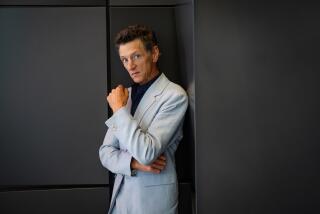L.A. Film Festival: John Hawkes in unusual detective tale ‘Too Late’
On Thursday night, the Los Angeles Film Festival was at the L.A. County Museum of Art to present the world premiere of writer-director Dennis Hauck’s debut feature, the suspenseful detective story “Too Late.”
LACMA’s Bing Theater was used in part so the movie, an entry in the festival’s U.S. fiction competition, could be screened in a 35-millimeter film print. (A follow-up screening at the festival’s downtown L.A. Live venue will be a digital projection.)
In the film, set and shot in Los Angeles, John Hawkes plays a private investigator who receives a call from a young woman and then spends the rest of the story putting together what happened to her. The style of the film becomes a vital part of its storytelling, as each of its five scenes is told in a single long, uninterrupted take.
INDIE FOCUS: Sign up for Mark Olsen’s newsletter about film
As a result, each scene comes to feel like a self-contained play that simultaneously fits into the fabric of the larger story, taking in a hillside park, a crooked businessman’s home, a strip club and bar, a drive-in movie theater and a hotel.
With its vintage-inflected aesthetics and unusual storytelling, the decision to shoot the movie using 35-millimeter film was a natural choice for Hauck.
“As you probably noticed, the whole thing was designed around the idea of, ‘Let’s have five scenes, and they’ll each be about as long as a roll of film will last,’” Hauck said in a Q&A following the screening. “So from the very beginning, I didn’t even know really what the movie was going to be about, I just said I can write about anything I want but it can only be five scenes, 20 minutes.”
Alongside Hawkes in the film are Crystal Reed, Dichen Lachman, Natalie Zea, Jeff Fahey, Rider Strong, Joanna Cassidy, Dash Mihok, Sydney Tamiia Poitier, Vail Bloom, Brett Jacobsen and Robert Forster. All but three of them (Reed, Lachman and Mihok) appeared onstage with Hauck following the premiere.
Hawkes acknowledged that it took him a long while to agree to do the film, apologizing to Hauck for any delays he caused.
“I’m glad we have this forum to talk this out,” Hawkes joked.
All of the actors present spoke briefly about their experiences shooting the film. Bloom, who spends much of her screen time naked from the waist down — her character is interrupted while changing clothes and then never covers back up — noted, “I’m feeling a little shy after watching that.”
In case anyone had any doubts, in the end credits is a note that there are no hidden cuts in the movie.
“There’s no hidden cuts, there’s a very obvious cut,” Hauck said with a laugh during a phone interview ahead of the festival. During the film’s final sequence, there is a single, very noticeable hard jump cut as Hawkes rides in an elevator at the Beverly Hilton.
Originally from Atlanta, Hauck has lived in Los Angeles for about 12 years. He has made a few short films while working the sorts of jobs one gets while trying to be a filmmaker — he was briefly actress Mary Louise Parker’s assistant and shot weddings on super-8 and 16-millimeter film.
The cohesiveness between the film’s story and the style of its telling is remarkable, transcending its novelty, and announces Hauck as just the sort of emerging talent the festival’s latest incarnation is looking to champion. The film has a buoyant, hold-your-breath excitement alongside its hard-boiled weariness that makes for a fresh combination.
“I look at it and it looks better to me,” said Hauck of shooting on film. “It just feels special to me, like a real movie. I love cinema and I don’t want it to be made up of the same raw materials of zeros and ones that everything else in the world is made up of these days.”
Working with cinematographer Bill Fernandez, Hauck shot the film using the Techniscope format that had it’s heyday in the 1960s and ‘70s. The specifics of the format, also used on recent films such as “Silver Linings Playbook” and “Argo,” allowed for longer takes.
The process for each scene was to block and rehearse with the actors for a day or two and then take another day or two to shoot. On average about 10 complete takes would be done for each scene.
“Sometimes I look back and choosing the takes was the hardest thing in the movie,” said Hauck. “It was so agonizing; there was great stuff, great performances scattered through all the takes of a scene. To really pick one and say goodbye to moments no one will ever see because they are in different takes, that was tough.”
The film was shot over a number of years — “with a lot of agonizing downtime in between,” added Hauck — starting in May 2012.
“It is a gimmick, but it was more of a way for me to make a movie and just challenge myself,” said Hauck of the film’s unusual style. “But I never liked pitching it that way, I didn’t want it to seem gimmicky. I was proud of the script and I felt like it could stand on its own and you could shoot it in a traditional coverage way and it would still be a good movie.”
Follow me on Twitter at @IndieFocus and subscribe to my Indie Focus film newsletter.
More to Read
Only good movies
Get the Indie Focus newsletter, Mark Olsen's weekly guide to the world of cinema.
You may occasionally receive promotional content from the Los Angeles Times.











